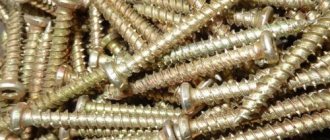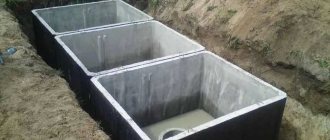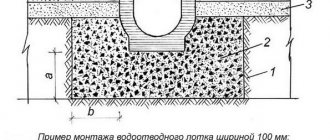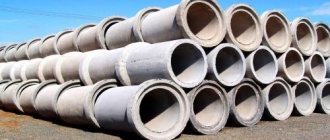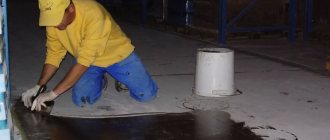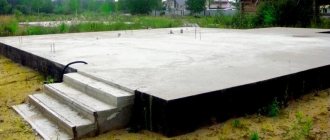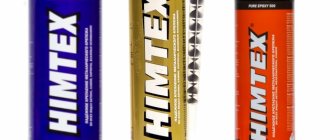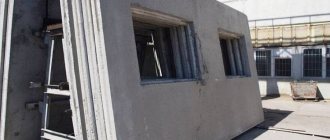Rain and melt water is one of the reasons for the destruction of residential buildings and utility structures. Therefore, they are trying to get rid of it, and quickly, moving it away from the foundations. Typically, such water is discharged into storm drains or outside the site: ravine, river, lake and other bodies of water. Trays assembled into one structure are called surface drainage or a surface drainage system.
Reinforced concrete drainage trays
When choosing a concrete drainage tray for any system, you first need to carefully study all the pros and cons of the product, technical properties, operating features, installation rules, varieties, etc. All this will help to correctly perform calculations and install a high-quality, reliable and durable system.
Varieties
Trays have different purposes. Although they are all designed to drain water and offer a certain standard design, you need to consider all options when choosing a product for a specific system.
Concrete drainage systems according to their intended purpose:
- Storm drains are used for installing channels to collect and drain atmospheric precipitation from the territory.
- Culverts are sectional channels created for gravity drainage of various types of water.
- Drainage trays are relevant for use in foundation structures and basement/basement floors.
- Telescopic - drain water from slopes and bridge structures.
- Edge - remove excess water from roadways to ditches.
- Sewer - used to transport wastewater to collector sewer systems.
Concrete drainage can be made in two modifications - prefabricated or solid. Both options can be of two forms: in the form of a parabolic or trapezoidal flat floor slab, as well as in the U-shaped bracket format with a round or rectangular gutter. All open trays require additional protective grilles.
Concrete drainage trays with or without gratings are available in more than 150 standard sizes, designated by the letter L (tray) and two numbers separated by a hyphen: the first displays the series number in the range 1-38, the second indicates the maximum permissible value of the vertical load on the tray (expressed in kN/m).
Additionally, behind the letter L, manufacturers can indicate their symbols, which are usually deciphered in price lists. So, Ldr is a drainage tray, Ld is an additional tray (of reduced length, which makes it more convenient to complete the route), etc.
Advantage of concrete products
The concrete tray for water drainage is produced in accordance with GOST 21509-85 using vibrocompression technology. The production uses concrete grades from M200 to M400 (in rare cases, usually a little less). The channels are densely structured and durable, resistant to various negative factors, changes in humidity/temperature, heat/freeze.
The design may contain expansion joints (necessarily sealed with bitumen mastic as waterproofing), which makes the products more resistant to mechanical stress. Plasticizers are introduced into the concrete composition, which significantly increase frost resistance, moisture resistance, and corrosion resistance. Also, additional strength of the trays is provided by a reinforcement frame made of steel rods of classes A-I and A-III.
The main advantages of concrete water trays:
- Completely waterproof.
- High level of resistance to various aggressive influences.
- Reinforcement of metals, which increases strength.
- Resistant to temperature changes, frost and heat.
- Ability to receive and discharge large volumes of water.
- Resistance to mechanical damage and vibration.
- Aesthetic appearance.
- Simple and quick installation.
- Long service life.
- Relatively low cost.
- The versatility of using trays for a wide variety of systems.
- Smooth surface, due to which not only water, but also debris is removed.
- Environmental friendliness and safety in operation.
- There is no need to carry out large volumes of excavation/installation work, due to which trays are often used in the installation of drainage systems in private households.
The products have quite a few disadvantages: heavy weight (which to a certain extent increases time, financial and labor costs for installation), considerable transportation costs, loss of all basic characteristics if the manufacturer does not comply with the technology.
What materials are drainage systems made from?
As a rule, drainage structures are made of metal, plastic, or a combination of materials is used when metal elements are coated with polymers. All materials have their advantages and disadvantages.
Metal gutters
Metal elements perform:
1.made of steel.
2. made of aluminum.
3.made of copper.
Galvanized steel products are inexpensive, have a long service life, withstand large temperature changes, and do not deteriorate when exposed to the sun.
Polymer coating
Metal drainage systems coated with polymer materials are widely used for installation on roofs made using metal tiles. The roof and gutter materials have the same wear and tear period, therefore, the entire roofing structure will have to be replaced at the same time.
Gutters cast from copper decorate the façade of the building and are practical to use. After some time, a patina will form on the surface, and the products will not oxidize. Gutter elements are heavy and expensive.
Plastic gutters
When installing gutters in a country house, plastic products are used.
As a material, plastic has its advantages:
1. The products are made of high quality and have an appropriate price. Plastic drainage elements are more expensive than galvanized metal ones, but are considered cheaper than others.
2.Plastic has a wide variety of colors.
3.They have sound insulation.
4.Do not undergo the formation of corrosive changes.
5.It is easy to install the elements yourself.
Among the disadvantages, it can be noted that the products are fragile and cannot withstand very low temperatures. In order not to overload plastic gutters during seasonal snow melting, you need to install snow retainers on the roof.
Plastic drains are made of vinyl and polyvinyl chloride, which are manufactured specifically for this design using a special technology. Vinyl can withstand extreme mechanical stress, is capable of restoring its shape after the load is relieved, and does not break. Suitable for areas with heavy snowfall, where the load on the gutters can break metal products.
Making storm drainage trays with your own hands
Despite the relatively low price of plastic drainage trays, there is an even cheaper option for arranging the system - making gutters yourself. This will make it possible not only to save money, but also to get a product with parameters that exactly match the needs of your site.
Making a drainage tray with your own hands begins with the production of a mold. For this, boards or laminated plywood with a thickness of 10-15 mm are usually used. A U-shaped shape is made from these materials, the elements of which can be fastened together using metal corners for greater strength. If you use boards for formwork, their thickness should not exceed 25 mm, and the surface should be free of knots. It is best to connect them together using wood screws; they hold the boards together well under the influence of concrete.
After the main part of the mold for making the gutter is ready, the molding part is made. The best solution for this is a regular plastic water pipe cut in half. The main thing is that its surface is as smooth as possible, since it is along the semicircular part of the gutter that water will flow. The concrete mixture is poured into the finished form.
Manufacturing a concrete tray for storm drainage
To form durable concrete, it is recommended to use the following materials:
- filtered sand without foreign impurities;
- crushed stone of medium or small fraction;
- Portland cement M400, which is characterized by a high level of frost resistance and strength (if desired, other types of cement can be used);
- fittings with a diameter of 6 mm.
In order for the concrete drainage trays that you will install into the storm sewer system to be as strong as possible, the ratio of cement, sand and crushed stone should be 1:2:4 or 1:3:5. In the second case, the amount of concrete produced will be greater, but its strength will be slightly lower.
When calculating the final size of a reinforced concrete drainage tray, it is necessary to take into account the installation of reinforcement. These can be individual rods or a mesh. The latter can be mounted with your own hands, placing the reinforcement bars at a distance of 5-10 cm from each other and connecting using electric welding or wire. After this, the resulting concrete mixture is poured into the mold, into which the cut plastic pipe is immediately pressed. You can disassemble the mold and remove the pipe a day after pouring the mixture.
The flat inner surface of the tray facilitates quick and efficient drainage of rainwater
The time for complete hardening of concrete is 28 days. After this, each tray must be carefully inspected for defects, pits and cracks. If they are absent, you can proceed with the installation of a storm sewer system.
The advantages of making it yourself include not only the exact size of concrete drainage trays you need, but the price will also be significantly lower than when purchasing a finished product. However, if you decide to buy plastic drainage trays for storm drainage, this will definitely save your time. So the decision whether to buy or make your own gutters depends entirely on your personal preferences.
https://youtube.com/watch?v=f9QqaUKm1hY
How to make a tray Step by step instructions.
If you decide to make a drainage tray with your own hands, then you should act in the context of the following scheme:
You should start by preparing the forms for pouring. Contrary to popular belief, they can be not only metal, but also polymer
It is extremely important to thoroughly treat the inner walls of the mold with machine oil. After lubricating the mold, it is necessary to secure the reinforcement in it; The parts of the reinforcement should be fastened not only relative to the shape, but also relative to each other. As a rule, this stage of work is carried out using gas or electric welding. The molds should be fixed before pouring begins; even slight movement of the selected containers is considered unacceptable and may not have the best effect on the quality of the finished product. After a week, you need to carefully remove the formed channel from the pipe; if necessary, you need to cover it with a layer of paint or any anti-corrosion compound that is not rough after drying
This will help improve the efficiency of the sewer system due to the smooth internal structure.
As a rule, this stage of work is carried out using gas or electric welding. The molds should be fixed before pouring begins; even slight movement of the selected containers is considered unacceptable and may not have the best effect on the quality of the finished product. After a week, you need to carefully remove the formed channel from the pipe; if necessary, you need to cover it with a layer of paint or any anti-corrosion compound that is not rough after drying. This will help improve the efficiency of the sewer system due to the smooth internal structure.
This video shows an artisanal manufacturing method.
Even with total adherence to the described technology, the service life of a tray made at home may differ significantly from the period of operation of a factory product, which in itself is logical. However, if you follow the described scheme, the tray you make will not be inferior to the one that was made in the factory in terms of efficiency during operation.
Let's see how to make a U-shaped block for water drainage
Roads for cars and auxiliary units on their territory seriously suffer from the destructive effects of precipitation and other atmospheric factors. Precipitation in the form of rain seriously changes the mode of operation of roads, so its effective and timely drainage plays a fundamental role.
The maximum harm to the stability of the structure is caused by the so-called. free water. The operation process is accompanied by significant fatigue of road surfaces, destruction of expansion joints, and the appearance of cracks. In order to delay this process as much as possible, drainage structures are used.
Installation of concrete, metal or plastic drainage trays with gratings: cost of work
The cost of installing a storm drainage system depends on the depth to which the gutters are dug. The cheapest installation (from about 1,800 rubles) is the installation of a shallow water drainage system, that is, to a depth of 1 m. Installation deeper than 1.5 m will cost more - 3,900 rubles and more.
Regardless of what material the gutters are made of, they are installed according to the following scheme:
- the type and size of trays is selected, their number and the degree of physical load on the entire system are calculated. Depending on the last parameter, the material from which the gutters are made is selected;
- The depth to which the trays will be buried is determined. You can entrust this matter to specialists or carry out the necessary calculations yourself. Please note that when calculating the depth of the trench, you need to take into account an additional 10 cm for a concrete or gravel pad. It is also necessary to provide a slope along which water will be drained into drains;
- a trench or several trenches are dug with a width of 50 cm and a length according to the number of gutters;
- Concrete or cement is poured into the bottom of the trench. To increase the strength of the base, it is recommended to reinforce it with a metal mesh;
Installation of plastic drainage trays
Concrete tray with cast iron grate for storm drainage system
Errors and how to fix them
Near the blind area in old houses, storm drainage was not installed at all or was not done particularly well. If the covering is hard, there is no need to disassemble it; the ground storm drain is laid along the extreme boundary with the required slope and taken to the well.
Most mistakes require dismantling and reassembling the system, but with a concrete base for above-ground systems this will be difficult to do, which is why it is so important to maintain the slope right away, during the construction phase.
What is important to know:
To prevent blockages, clean sand traps on time;- slopes should be optimal (not large, not small), approximately 2-3 cm per 1 m;
- do not neglect the installation of distribution wells, they reduce the load on the system and serve to detect fences and allow them to be easily removed;
- trays are heavy, the base under them must be reliable, since shrinkage can damage the angle of inclination;
- if the system is used in winter, the pipe must run at a sufficient depth, below ground freezing.
To ensure that the system is sealed and efficient, it is recommended to use the services of specialists for calculations and installation.
Surface drainage system
Drainage systems are designed primarily to collect rain and melt water, rather than groundwater. In the future, they must carry out the transfer of water to the sewer, where such water will undergo filtration and return to nature, for example, evaporate or merge into rivers. Surface drainage is a prerequisite for construction. According to engineering standards, every construction project must be equipped with such a system at the planning stage.
Surface drainage systems are available in several configurations, which are expressed in assembly systems. Thus, each of the systems is designed for a certain volume of water, loads, etc. Drainage trays are used in linear surface drainage, the purpose of which is to collect water in large volumes. This type functions most successfully when it comes to asphalt areas, highways and the like.
In some cases, it is necessary to install sand traps, the purpose of which is to collect debris, filter sand and large particles, which in theory can clog gutters. Their presence greatly increases the service life of storm drains.
Components
If we talk about industrial storm drainage, it consists of several elements.
- Storm water inlet. It is designed to drain water from the surface locally. To prevent debris, leaves, etc. from clogging the rain inlet and other elements, a siphon is used. It serves as a kind of partition. A special basket is provided for collecting waste.
- Rain well. Serves for transporting wastewater. It is constructed only at the end of the assembly of the entire storm sewer. They are also needed in cases where it is necessary to regularly drain large areas of soil in a short period of time.
- Tray. Actually, what we see on the surface: a trench made of materials resistant to water. The tray transports water, moving it from the site.
- Pipes. Mounted on rain gutters. Through these pipes, water subsequently moves into the sewer itself. The pipes are located underground so as not to spoil the overall appearance of the site.
Installation Tools
In order to install water intake gutters, you will need to buy some tools. It may turn out that you already have some of these tools, but for others you will have to go to a specialty equipment store. In any case, the tools cannot be called scarce - they can be found in any large construction hypermarket.
- Shovel. It will serve to make a trench under the tray. Make sure the nozzle is sharp. This will greatly facilitate the work.
- Buckets. It is advisable to have at least two buckets. They are useful for transporting sand to the installation site.
- Concrete mixer. In some cases, owners decide to firmly fix the gutter in place using concrete. In these cases, it is better to mix it not by hand, but using a special machine. Then the concrete will be homogeneous and will lie evenly.
- Hacksaw. With the help of this simple tool you will have to saw parts. Depending on what material the drain is made of, you will need a hacksaw of a certain type: for metal, capable of sawing concrete, and so on.
- Hammer. It is needed for fastening parts together, adjusting shapes and simply compacting the tray in place.
- Saw or grinder. If you choose a metal gutter, then purchase a diamond saw or diamond blade for an angle grinder, especially if you are dealing with durable metals such as cast iron. Then there will be no problems with quickly sawing parts.
Overview of operational areas
Drainage concrete parts are used only for hard surfaces, since the removal of excess moisture from the soil is carried out by a completely different system - drainage. Trays for storm sewer communications are used in the following cases:
- near highways;
- on the streets of the city;
- on pedestrian paths (asphalt, tiled);
- on concrete platforms.
- inside various production workshops;
- in car parks;
- near various objects related to the city’s infrastructure.
Important! It is not recommended to install a concrete channel near a private house. In such cases, trays are usually placed in dug trenches without taking into account the degree of heaving of the soil. Soil heaving is a characteristic that reflects deformation shifts in the soil during its transition from thawed to frozen state. As a rule, manually laying a channel from concrete trays leads to their displacement due to heaving of the soil in winter.
Trays are laid along roads or railways, parking lots and other objects where the outflow of storm and melt water is necessary
Such products, in combination with a special blind area, produce high-quality removal of melt, waste and rain moisture. Thanks to concrete channels made from drainage trays, the service life of road and other hard surfaces is significantly increased.
Typical storm drainage designs
In the manufacture of storm drainage trays, a variety of materials are used, from cast iron to polymer plastic. But at the same time, all products have a standard design and comply with established standards EN 1433. In the range of offered and manufactured products you can find the following standard design of trays:
- A storm drain tray made in the form of a simple long U-shaped or round gutter without a lid. Such a product is installed without additional reinforcement in a pre-prepared trench with access to the central water collection point.
- A storm drain tray made in the form of a standard elongated gutter, but with a reliable lattice cover along the entire length of the product. The grate prevents various types of debris from entering the sewer drain and prevents blockages in the drainage system.
- Slotted trays for storm drainage. This type of design looks like a long gutter with a slot for water to flow into it.
- L-shaped trays for storm drainage. These products look like slotted ones, only instead of a central hole in the tray they have a special protrusion in their upper part, made in the shape of the letter G. Such products are suitable for installation both in domestic and in more complex industrial conditions (on highways, highways , runways, etc.).
As for the methods of manufacturing storm drainage trays, they completely depend on the specific material from which the products will be made. Thus, in the case of using plastic polymers with additives, the extrusion method is used (extrusion under high pressure and at hot temperatures). If concrete or metals (cast iron, steel) are used, then the casting method is used.
Preparing to make a gutter
When manufacturing a device for transporting concrete, the following must be taken into account:
- The structure must connect the concrete mixer container with the formwork of the future foundation.
- It must be at a certain angle, which will allow the mixture to flow freely under the influence of its own weight to the desired location.
To make the structure you will need the following tools:
- Hacksaw or saw.
- Yardstick.
- Bulgarian.
- Hammer.
- Square.
- Screwdriver.
Materials to be prepared:
- Edged board 25x120 mm.
- Nails or screws.
- Linoleum, tin or plastic film.
- Blocks or timber for supports.
Formwork diagram.
In addition, when starting the manufacturing process, you should take into account several basic rules that impose special requirements on devices of this type. Thus, the manufactured gutter along its entire length must have a constant level of slope. If the slope decreases, the flow of the concrete mixture may slow down, which will then lead to clogging or premature hardening of the concrete. If the slope of the device, on the contrary, increases and pouring begins to be carried out faster, the concrete solution may disintegrate into separate parts, which will inevitably lead to a deterioration in the quality of the mixture. The base of the foundation will lose its reliability and will be short-lived.
When creating a gutter, the level of its taper should be calculated based on the degree of delivery distance of concrete, as well as its consistency. Liquid mixtures that the mixer delivers over short distances allow for small slopes. If the mixtures are quite thick or are supplied over significant distances, then the gutters should be as steep as possible.
The preservation of the homogeneity of the concrete mixture is also influenced by such an indicator as the shape of the structure. A high and narrow chute, made by yourself, allows individual particles of the solution to come closer together when transporting the mixture. But at the same time, it must be made deep enough so that the concrete does not overflow over the sides when passing through it.
Installation technology
It makes no sense to consider installation technology in public buildings or commercial facilities, since for such work, as a rule, a team of professionals is hired. Installation on your own personal plot is a completely different matter. Then it’s really worth studying the work better so that, if necessary, you can carry out the installation yourself or immediately see if your workers are violating the technology.
Once the tray is selected and the tools are prepared, some preparatory work needs to be done. These include markings on the ground. This is done in order to clearly understand where exactly the drainage system will be located and how wide it can be made. Keep in mind that it is best to locate such objects in the lowlands, on the slopes of hills, if they are on your site. Then the water will collect there, and not accumulate somewhere on the site, leading to the leaching of useful substances from the soil.
Subsequence
To install a drainage tray yourself, use the following step-by-step instructions.
Dig trenches for installing trays. There should be as many of them as the number of drainage systems planned to be installed
Pay attention to the size of the recesses, their depth and width: the drainage channel must fit completely there. For complete installation and subsequent work, the storm drains must be positioned at an angle. If you make them on a plane, then the water will stagnate in them and not flow where it should.
The slope fluctuates greatly: it can be a meter high, or it can be only 1 cm. Trenches dug in compliance with the above conditions must be well compacted. To do this, you can use ordinary sand, which has a drainage effect.
Pay special attention to the next point if your plans include installing plastic products. Sand compaction alone is not enough here.
It is imperative to create a concrete base, since without it the strength of the polymer drain will drop significantly. The concrete box is made in the shape of a tray. It also serves to compensate temperatures. In it, the plastic gutter will not deform, being compressed by the surrounding earth. The presence of a grille is optional, but desirable as it provides additional protection. Debris, leaves and other large objects will not fall into the storm drain, clogging it. Pay attention to the rules for installing sewerage. It must be placed half a centimeter below the ground level, otherwise it will protrude and get in the way. To connect the trays, you need to insert one into the other at the locations of the grooves. In the future, you need to seal the joints well. High strength silicone sealant is suitable for this.
Connection types
This refers to the direction in which water should flow through the tray. Depending on this, the grooves are calculated. The channel must not be positioned in any other way than as indicated in the diagram. By the way, the layout diagram of the tray itself, as well as its individual elements, is attached to each individual set, so it will not be possible to consider any general sequence.
Blitz tips
Most often, installation of drainage gutters is carried out along the perimeter of a residential building, plot and near the garage
However, it is not necessary to fulfill this condition; it is important that the storm drainage system is installed where it is most needed.
The storm drainage system can be installed with or without sand trays. If the installation involves the use of one, then the connection to the sewer drain will be made through the installation of a sand collector
Before installing it, you need to knock out the plug. If a sand collector is not used, a hole for the drain is cut directly in the tray. The hole is drilled along the contour from 2 sides, after which it is knocked out with a hammer from the inside.
To make corner connections from reinforced concrete trays, use a saw. To create a 100-degree angle, cut 50-degree corners on each connected gutter. The cut is carried out while gripping the walls of the product. The joints are sealed using acrylic or bitumen sealant.
If constant high loads on drainage are planned, the concrete layer under the gutters should not be less than 10 cm.
To prevent clogging of the drainage system, it is recommended to clean it every two weeks.
When choosing a product, it is recommended to pay attention to the brand of concrete from which the trays are made. The best grades of concrete are B15, B20 and B25. No less important is the grade of steel that is used to strengthen the structure. Classes A-1, A-3, BP-1 are best suited for this. The cross-section of steel rods should not be less than 8 mm.
Criterias of choice
When going for gutters, you should take into account the following nuances:
- Product throughput and load class.
- Material of manufacture. The transportation process and the complexity of sewer installation depend on it.
- Quality of connections and grooves. They ensure the integrity of the final communication.
- Presence of factory slope. It is extremely important if it is not possible to create a slope when digging trenches due to the characteristics of the soil or topography on the site.
When purchasing, you should pay attention to the grille. It is advisable that it have a locking mechanism if the system will be installed in public places.
Rules for installing water drainage trays
In order to properly install storm drainage trays at any facility, you must adhere to clear rules. Otherwise, the water drainage system will not have the desired effect and will lead, at a minimum, to blockages, and at maximum to waterlogging of the area or damage to the concrete base of buildings, paths, etc.
Therefore, select and install storm drainage trays according to the following principles:
The throughput of the product you choose should be calculated using the formula = average monthly precipitation multiplied by 25%. Thus, it will be possible to choose the right drainage tray for a specific area.
The material from which the gutter will be made must be appropriate for your facility. It is unlikely that a powerful cast iron tray will be the right solution for domestic use in the garden or country house. When laying storm drainage trays, maintain a slope towards the sewer system at the rate of 1 cm per meter of product. For a high-quality water drainage system, you need to use a good substrate for the gutters. It is better to use a sand and gravel bed 10 cm thick, or at least a crushed stone bed of the same thickness.
You can choose lighter grates for domestic use on storm drain trays. Galvanized steel is suitable
In addition, it is better to fix all the grilles using special locking connections. It is also important to install a sand collection system in the gutter water drainage system. This will prevent siltation and contamination of communications.
Characteristics of drainage trays
The technical characteristics and properties of concrete drainage trays are determined by their purpose and production method. The higher the load that the tray can withstand, the higher the grade of cement used for its production. Reinforcement from steel rods is used for strengthening.
Main characteristics of trays according to GOST requirements:
- Compressive strength corresponds to minimum concrete grade M300.
- The filler fraction is a maximum of 15 millimeters.
- Cement for production is at least M400 grade.
- The thickness of the concrete above the reinforcement is a layer of at least 15 millimeters.
- Appearance – absence of any irregularities and sagging, cracks and chips.
The dimensions of the products can be different - the standard ones assume a length of 1000 millimeters, width and height, wall thickness can be different.
How are the dimensions of drainage trays indicated:
- DN – internal width in millimeters (100, 150, 200 and 300, 500 in Europe, in Russia 110, 150, 160, 200, 300 and 500 are used). If the marking indicates DN 500/150, then the second number indicates the internal depth.
- L – section length, can be in the range of 50-300 centimeters, less often you can find 6 meters or 70 centimeters.
- B – the outer width of the tray, varies from 40 to 190 centimeters.
- H – tray height, varies in the range of 38-150 centimeters.
Materials, tools, procedure
The dimensions of the future product are taken based on the specific distances from the planned installation of the mixer or concrete mixer to the farthest point of the structure being poured.
In private low-rise housing construction, the length of the tray usually does not exceed 12 meters. The width of the tray is taken to be the “width” of a shovel plus 5 centimeters on each side (usually 300 millimeters), the height of the wall is the width of the existing edged board 150-200 millimeters.
The following materials and tools will be required:
- Edged board 25x150 or 25x200 of the maximum possible length for the tray box;
- Wooden block 40x40 or similar to strengthen the box;
- Wooden block 50x50 or similar for supports under the box;
- Galvanized or roofing iron for lining the bottom of the box;
- “Seventy”, “25”, “weaving” nails or wood screws;
- Hammer, wood saw, screwdriver, tape measure;
- Angle grinder with a metal disc or metal scissors. For cutting galvanized or roofing iron.
In order to save on expensive galvanized iron, you can independently plane the side of the boards along which the concrete will be transported as smoothly as possible. For these purposes you will need a plane or jointer.
Advantages and disadvantages
The main advantages and disadvantages that any storm drain has are determined by the characteristics of production. The most popular are products created by vibration pressing, which provides excellent technical characteristics and features.
The main advantages of storm drains:
High level of resistance to moisture and sudden temperature changes. Resistance to dynamic loads and corrosion. Safety in operation and environmental friendliness. Long service life - up to 70 years. Good mechanical strength. The versatility of using the element to create various systems. Stability due to high weight, which is important especially when large volumes of wastewater accumulate. Easy to install and maintain. Relatively low cost.
Among the disadvantages of concrete products of this type, it is worth mentioning such as heavy weight and the need to bring special equipment to the site, and fairly high transportation costs.
Metal molds for the production of concrete sand traps
The design department develops metal molds in such a way as to ensure ease of transportation, manufacturability of the production process at the customer’s enterprise, the ideal shape of the most complex surfaces of the finished product and maintaining the rigidity of the mold structure during its entire service life. Metal molds for sand catchers produced have a service life of up to 500 castings and fully comply with GOST standards.
Estimated cost
For price analysis, a plastic gutter of class A15 was chosen (its dimensions are 1000x135x95, and the flow area is 54.2 cm2), since this model is the optimal solution for arranging a drainage system in a small summer cottage.
Photo of the gutter for which the price analysis was carried out
How prices are distributed in different regions can be seen in the table presented.
| City | Cost ($) | City | Cost ($) |
| Bryansk | 7,7 | Kazan | 7,55 |
| Krasnoyarsk | 7,6 | Omsk | 7,9 |
| Moscow | 7,5 | St. Petersburg | 7,5 |
The table clearly shows that storm drainage trays cost approximately the same both in the capital and in Bryansk, Omsk or Kazan. The insignificant difference does not exceed the permissible error limits. This model of gutter is also sold in other cities, while the price trend continues.
Lattices
Speaking about drainage trays, we should talk about the receiving grates that often come with them; they can be made of plastic, cast iron or steel.
Plastic products are installed on the gutters of the drainage system in places where strong mechanical loads are not expected, for example, in a park or personal plot. The advantages of plastic gratings include:
- light weight, which allows you to install it yourself;
- affordability;
- if necessary, changing the size of the product is not difficult;
- long service life.
The limitation on use is the insufficient strength of the product, which narrows the scope of application.
Grilles made of plastic
Steel gratings are stronger than their plastic counterparts, but they are much more expensive. Among the advantages of these products are the following:
- light weight, making installation and transportation easier;
- the material used is stainless steel, which has a positive effect on durability;
- excellent appearance brings a significant aesthetic component, which makes this type of grille very popular.
Stainless steel storm grates
Cast iron gratings for storm drainage trays are the most durable of all types. They are installed where it is not possible to use other types due to their insufficient mechanical strength. Characteristic features of these products:
- resistance to corrosion and temperature changes;
- high mechanical strength;
- long service life.
The fairly high cost is the only drawback of cast iron structures.
Drainage cast iron grates
What is required for the device?
Storm drain elements that are necessary to create a working system:
- Storm water inlets. They collect water and are located in the corners of the building and in other places where drainpipes are installed. They are part of the point storm sewer design. Install it exactly under the drain so that the stream hits the very center.
- Receiving trays or drainage channels . Installed in a ditch of an open storm drain. In order for the water to flow towards the drain well, it is necessary to create a slope in its direction, approximately 2 cm by 1 m. This is part of the design of a linear storm drain; their markings are similar to plastic rain inlets. Optimal classes A and B.
Pipes. Installed at depth, underground.
When water gets into them, it moves towards the well; they are also mounted at an angle. Plastic pipes are most often used; the diameter depends on the load. The calculation is made using a special formula, which also determines the optimal slope of the system.It is recommended to consult specialists for an accurate calculation; this will directly affect whether the system can cope with the flow during periods of heavy rainfall.
- Sand catcher. It is also a filter, which is part of the storm water inlet structure. The same filter system is installed before discharge into the collector, at the request of the owner of the site.
- Inspection wells . These are structures that are created at places where pipes turn or every 30 meters if the pipeline is straight, as well as at places where pipes change to a larger diameter. Grids are installed on top of them so that it is possible to observe the condition of the sewerage system. The walls of the wells are reinforced with concrete, the upper border is 20-30 cm above the ground level so that water does not get in there. The base is laid with crushed stone.
A place for receiving water must be organized if it is not provided for by the landscape. For installation, you will need to dig a well, create drainage and strengthen the walls (with concrete rings or car tires).
The top of the collector well is covered with a lid; the water can be used for household needs. It needs to be done in advance in order to direct the pipes to a specific place.
AQUA-TOP DN90 H100 with stamped galvanized grille
Submit your application
Office telephone numbers,
Drawings AQUA-TOP DN90 H100 Download drawing in DWG, DXF, PDFAq_DN90_h100_art1091 (2) (dwg)Aq_DN90_h100_art1091 (2) (dxf)Aq_DN90_h100_art1091 (pdf) Documentation
We design drainage systems for free from 1,000 m2
Colors :
black
grey
Load classes
Class A15 (15kN/1.5t) Pedestrian areas of dachas, cottages, courtyards, bicycle paths, etc.
A15
Characteristics:
- hydraulic section DN 90;
- weight – 1.5...1.8 kg assembled with grille;
- no special grille clamps required;
- vertical pipe for connection with a tube with a diameter of 110 mm;
ADDITIONAL CHARACTERISTICS
Dimensions: 1000x135x100
Main advantages:
Drainage channels
“Aqua-Top” series are supplied assembled with plastic and galvanized gratings. This is the most economical series of plastic channels. They do not require special grille clamps. They are recommended for installation in pedestrian areas, park areas, private households, and at the entrances to private garages for passenger vehicles. There are two versions of this channel, with plastic and stamped galvanized grating. Load class A15.
Types of trays used
There are several types of concrete trays for water drainage:
Concrete
Such gutters are considered the most durable in this category, they can withstand external loads in the range of 60-90 tons. Made by adding cement. They are used to drain stormwater after precipitation into sewers.
Polymer concrete
They combine the qualities of concrete and plastic water drains. They are made from quartz sand and granite chips with the addition of special polyester and epoxy resins. In this case, cement is replaced with polymer compounds, as a result of which the structure is resistant to various chemical elements.
The plastic included in the material makes the structure many times lighter compared to concrete. For private construction, gutters with and without gratings are used; their weight is an order of magnitude less than reinforced concrete trays.
Polymer sand
Gutters of this type are the most modern technological solution among drainage trays; they have special plasticity and a very long service life. The gutters are made from polymer chips with the addition of special fine sand. They are not inferior in strength to concrete products, but are lightweight, making them easy to install.
Polymer composite gutters
Composite drainage trays are produced by mixing various materials. The production of drainage trays is carried out using the following materials:
- a mixture of concrete mortar with polymer material;
- a mixture of sand with polymeric materials and other auxiliary additives.
The main advantage of these drainage gutters is that the mixture of polymer material with concrete or sand can significantly increase their strength characteristics. In other respects, these products are not inferior to their plastic counterparts.
The drainage composite tray consists of a gutter itself and a protective grille. In addition, such elements are lightweight, which allows them to be installed much faster than their concrete counterparts.
Types of sewer drains
There are three main types of storm drainage trays on the world market:
- Cast iron products for water drainage;
- Concrete trays for storm drainage;
- Plastic structures.
Let's take a closer look at each type.
Cast iron
This type of sewer pans is made from two main types of cast iron:
- ISO 185 - with the inclusion of lamellar graphite grain;
- EN1563 - metal with the addition of spherical graphite grains.
Such a powerful and durable product, thanks to its enhanced tensile and compressive resistance, is used only in industrial and complex facilities such as airports, long highways and runways.
At the same time, cast iron rain gutters are quite large. Thus, the maximum length of one gutter can be 50 cm, and its width - 20 cm.
Concrete trays
Popular products for use within the city. Many of us often observe the operation of the city drainage system during a summer rainstorm. The production of concrete sewer storm drains occurs using special polymer additives or reinforcing fiberglass in the concrete mixture. Thus, the finished product is more durable than standard reinforced concrete products.
Concrete storm drainage trays are produced using the vibration casting method, that is, a mold with reinforced concrete reinforced but still soft mixture is immersed on a vibrating table for greater shrinkage of the composition. This allows you to obtain greater density, and hence the strength of the finished product.
The parameters of concrete trays vary within the following limits:
- The length of the finished extended gutter is 500-4000 mm;
- The width and height of the finished storm drain can be from 140x150 mm to 430x880 mm.
Plastic products made to order in: overview of advantages
By entrusting the production of plastic parts to professionals, the customer will receive the following advantages:
- Accuracy guaranteed. Simple and complex products are produced with high precision. For each batch, a metal mold is developed, in the design of which the details of the future workpiece are worked out and taken into account. Even workpieces with bends and numerous holes rarely require additional refinement and correction.
- Prompt execution of large orders. A large volume of finished products will be delivered to customers in the shortest possible time. The main time expenditure occurs at the preparatory stage, and then the workshop engineers can quickly produce batches with any number of products.
- Customer focus. The company carefully monitors the market situation and changes the list of products based on current demand. Focusing on the interests of customers allowed the manufacturer to provide specialized services at the European level, offering competitive terms of cooperation in terms of prices, terms and logistics.***
